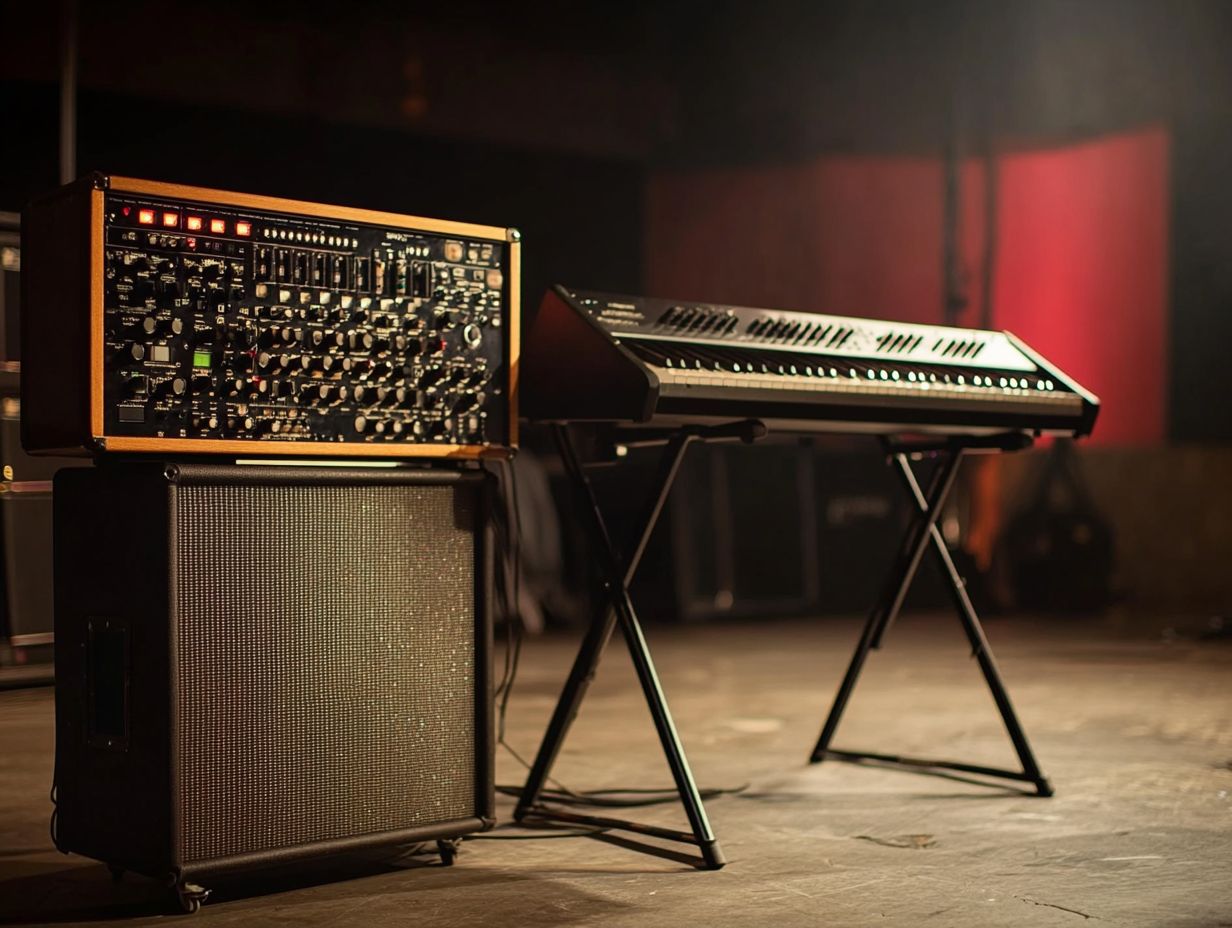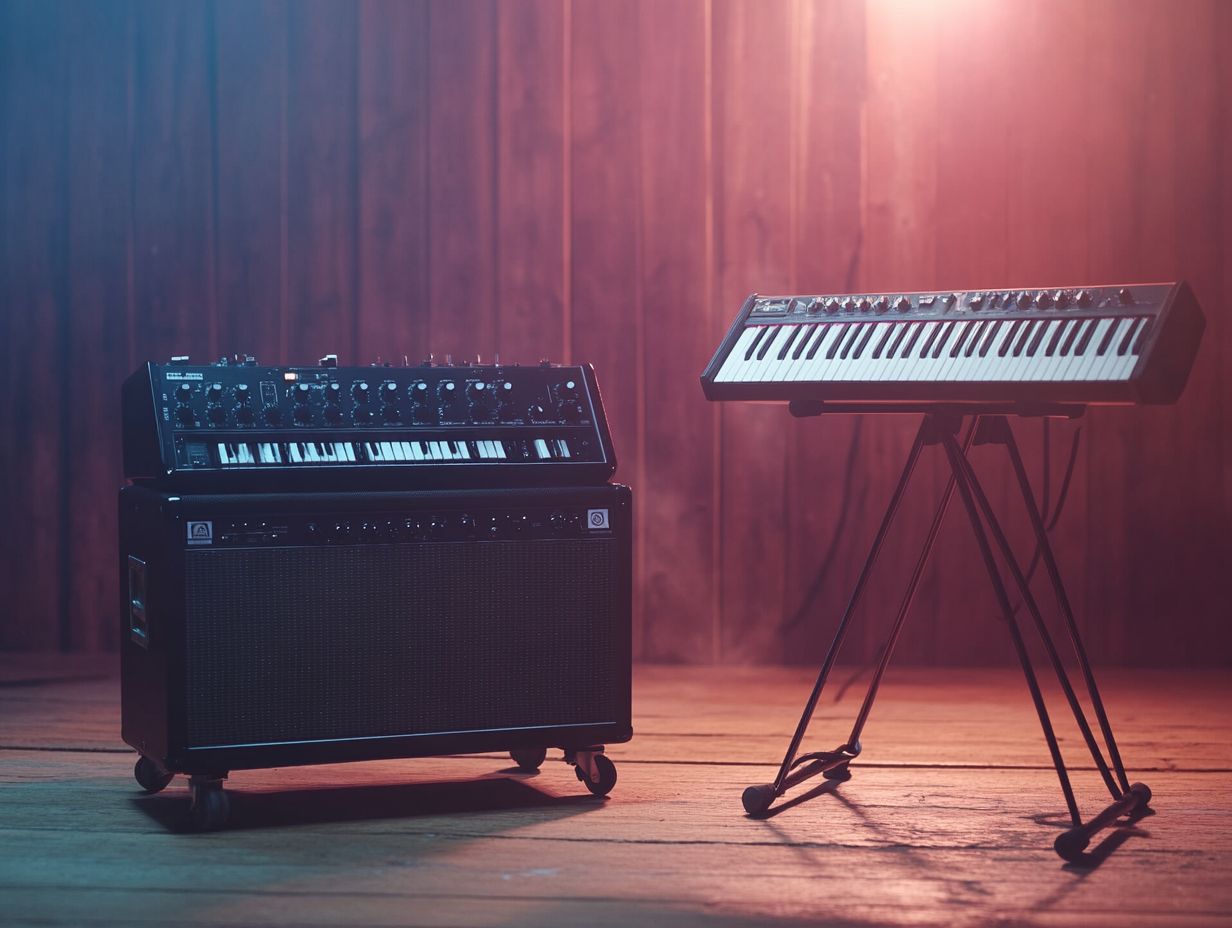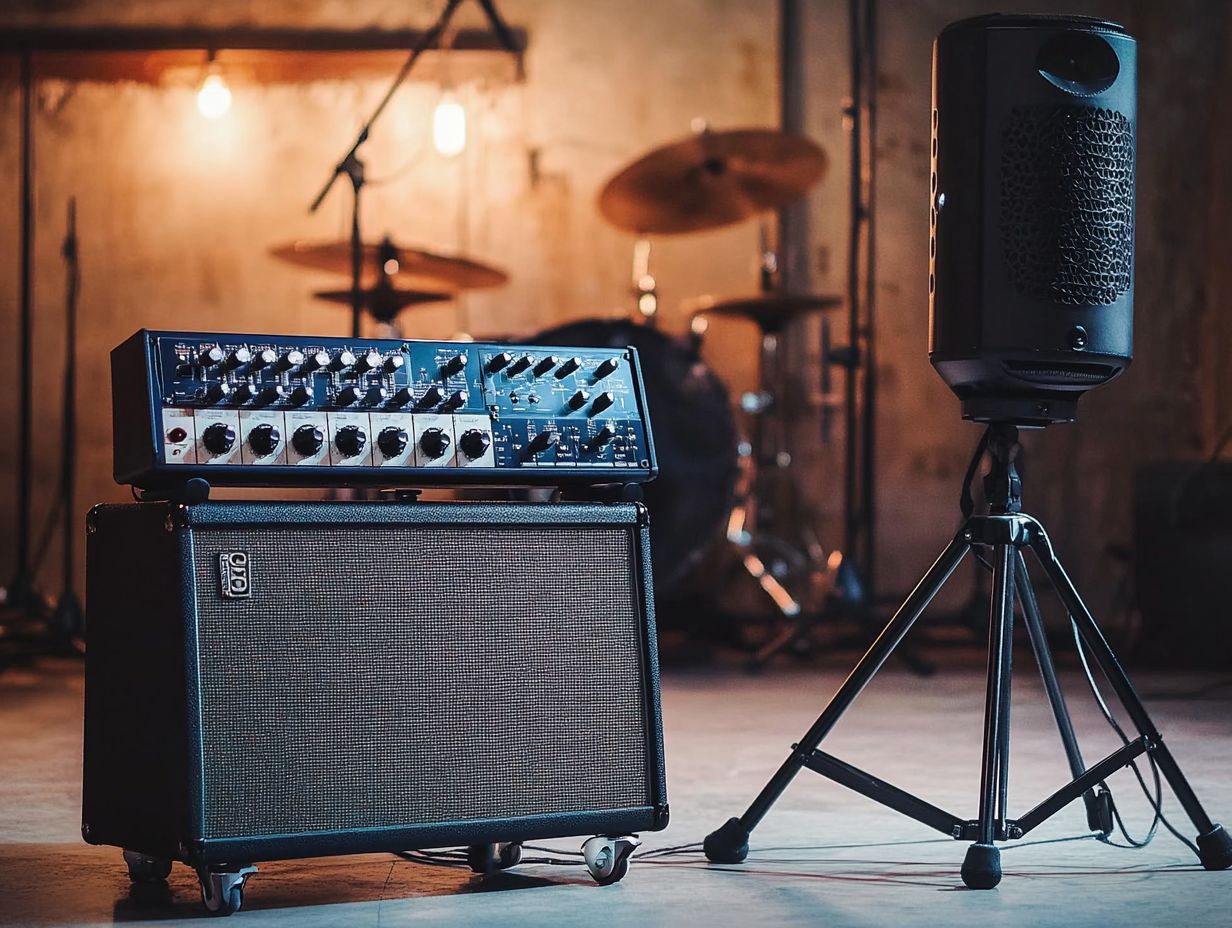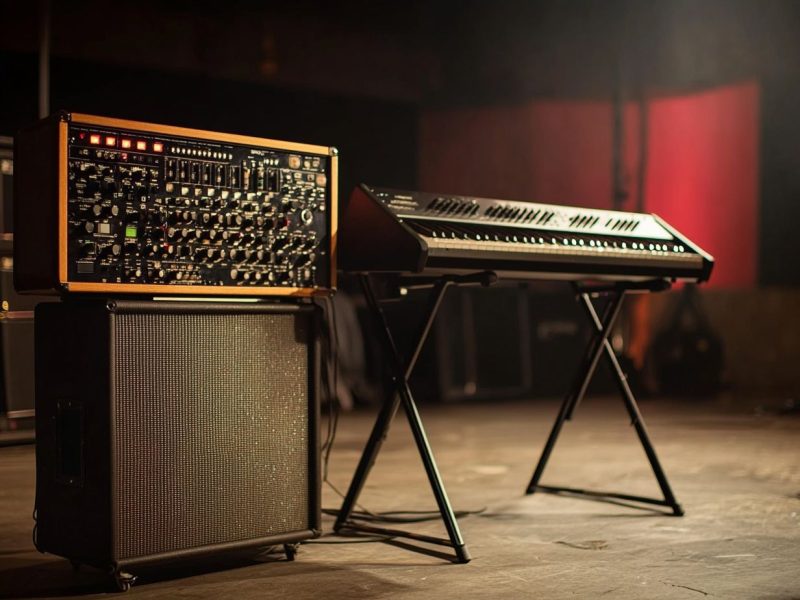When enhancing the sound experience, selecting the appropriate equipment is essential.
This document examines the distinctions between keyboard amplifiers and PA speakers, emphasizing critical factors such as sound quality, portability, and price. It provides a detailed analysis of the unique advantages and limitations associated with each type, thereby aiding in understanding their sound output and versatility.
By the conclusion of this examination, you will possess the necessary insights to choose the ideal equipment that aligns with your specific needs and budget.
Explanation of Each Type of Equipment

Understanding the various types of audio equipment, including keyboard amplifiers and PA speakers, is essential for achieving optimal sound reinforcement during music performances and live sound events.
Each category of audio equipment has distinct features and specifications that influence sound quality, frequency response, and overall performance characteristics. With choices available from active speakers with built-in amplification to passive speakers that require external power sources, selecting the appropriate speaker type can significantly impact the clarity and dynamics of sound.
This knowledge is critical for sound engineers and musicians, as it directly affects the complexity and effectiveness of setups in performance venues.
Sound Quality and Clarity
The primary factors influencing the sound quality and clarity of any audio system are the design and characteristics of the equipment utilized, which directly impact the fidelity and dynamics of the sound produced.
Achieving high audio fidelity is essential for ensuring optimal vocal clarity and instrument amplification, which is particularly critical during live performances.
Various elements, including the selection of speaker design and amplification types, significantly contribute to shaping the audio experience for both musicians and their audiences.
A strong emphasis on sound clarity is crucial for effectively conveying every nuance of a performance to the listeners.
Differences in Sound Output
The variations in sound output among different audio equipment can be attributed to several critical factors, including frequency response, power output, and impedance. These elements significantly influence how sound is projected and distributed throughout a venue, thereby affecting the overall audio experience during live performances and rehearsals.
A thorough understanding of the relationships between speaker sensitivity and impedance enables sound engineers to select the appropriate equipment for optimal sound projection and distribution. By examining these differences, users can customize their audio setups to align with specific performance requirements and musical genres.
For example, frequency response represents a speaker’s ability to reproduce audio across a range of pitches, which is vital for tasks such as mixing or mastering music. A studio monitor with a flat frequency response provides a more accurate sound representation, while a subwoofer with a frequency range optimized for low-end sounds enhances bass-heavy genres such as hip-hop and EDM.
Power output pertains to the wattage that a system can handle, directly impacting volume levels and dynamic range; a higher power output can effectively drive larger speakers and produce clearer, more impactful sound.
Additionally, impedance influences the efficiency of an audio system’s performance; for instance, an 8-ohm speaker paired with an amplifier designed for similar impedance levels results in a more reliable performance and improved sound quality overall.
Portability and Versatility
Portability and versatility are essential factors to consider when selecting audio equipment for live sound applications, as they greatly influence the complexity of setup and the capability to perform across various venues.
Musicians frequently prioritize gear that is durable and easy to transport, ensuring they can deliver consistent performances irrespective of location. The capacity to adapt equipment for diverse settings, ranging from intimate rehearsal spaces to large performance venues, enhances the overall versatility of the audio system.
Choosing equipment that strikes a balance between portability and sound performance enables musicians to effectively meet their specific preferences and requirements.
Benefits and Limitations of Each

When evaluating audio equipment, it is essential to comprehend the benefits and limitations of each type, including active and passive speakers, to make an informed decision regarding sound versatility and performance outcomes.
Active speakers, which feature integrated amplifiers, streamline the user experience and are ideally suited for individuals who prioritize convenience and immediate setup, such as musicians during live performances or casual listeners at home.
In contrast, passive speakers, which require additional amplification, provide audiophiles with the opportunity to customize their sound experience through various components, appealing to enthusiasts who seek premium sound quality.
The choice between these two options often depends on the specific context; active models are generally more user-friendly and space-efficient, while passive designs can deliver superior performance when properly configured.
Additionally, considering price factors and exploring options from reputable manufacturers such as Yamaha, Fender, and Mackie can further assist in selecting audio solutions that align with individual preferences and budget constraints.
Price and Value
The price and value of audio equipment are determined by a range of factors that influence cost, including performance characteristics, brand reputation, and the specific features offered by the equipment.
Higher-priced models typically include advanced capabilities, such as built-in effects, equalization settings, and superior audio fidelity, which can significantly enhance live sound experiences. However, there are also budget-friendly options available that provide substantial functionality, making it essential to find a balance between cost and the desired performance outcomes.
Understanding these factors is critical for musicians and sound technicians aiming to optimize their investment in audio equipment.
Factors Affecting Cost and Worth
Several factors play a crucial role in determining the cost and value of audio equipment, including brand reputation, performance characteristics, and overall durability.
For example, while a high-end mixer from a reputable brand may appear expensive, its longevity and reliability can justify the investment, particularly for professional usage in demanding environments. Additionally, features such as built-in effects, compatibility with various software, and user-friendliness significantly influence a buyer’s decision. A portable speaker with exceptional battery life and weather resistance may be preferred by individuals who require adaptability during outdoor events.
Consequently, prospective buyers are encouraged to carefully consider these specific elements—brand heritage, technological features, and overall build quality—when assessing their budget for audio equipment.
Choosing the Right Equipment for Your Needs
Selecting the appropriate audio equipment for specific needs necessitates a thorough evaluation of several factors, including the preferences of the musician, the types of performance venues, and the necessary connectivity options, such as XLR inputs and Bluetooth capabilities.
It is essential to comprehend the specific requirements associated with each type of performance—be it live sound, rehearsals, or home studio setups—as this knowledge is fundamental to making an informed decision.
Furthermore, assessing the complexity of the setup and the desired sound quality will assist individuals in choosing equipment that is best suited to their unique performance requirements.
Considerations and Recommendations

When selecting audio equipment, several key considerations and recommendations can significantly enhance the decision-making process, particularly for sound engineers and musicians.
Evaluating performance characteristics such as sound dynamics, feedback suppression, and overall sound quality is essential for achieving the desired audio experience.
Recommendations for specific equipment types, including audio mixing consoles and stage monitors, can guide users toward solutions that align with their specific needs and preferences. This method ensures that the selected equipment facilitates optimal sound projection and clarity during performances.
Along with these factors, understanding the typical environments in which the equipment will be utilized is crucial.
For instance, portable setups may benefit from lightweight speakers and compact mixers, while studio environments often require more robust and feature-rich devices, such as studio monitors and high-quality microphones. Users should also take into account connectivity options, as versatility in linking devices can greatly enhance workflow efficiency.
For musicians, selecting headphones that offer accurate sound reproduction can significantly improve practice sessions, while sound engineers may prioritize equipment that provides extensive customization and control to fine-tune audio output. These considerations are vital in selecting the appropriate tools to create an exceptional auditory experience.
Frequently Asked Questions
What is the difference between keyboard amplifiers and PA speakers?
Keyboard amplifiers are specifically designed for use with electronic keyboards and focus on accurately reproducing their unique sound. PA speakers, on the other hand, are designed for general use and reproduction of a variety of instruments and vocals.
Can I use a keyboard amplifier as a PA speaker?
Technically, yes, but it may not provide the best sound quality for instruments and vocals. Keyboard amplifiers are not designed to handle a wide range of frequencies and may not have the necessary inputs for microphones and other instruments.
What are the benefits of using a PA speaker over a keyboard amplifier?

PA speakers are often more versatile and can handle a wider range of frequencies and inputs, making them suitable for use with a variety of instruments and vocals. They also tend to have more power and can cover a larger area, making them ideal for live performances or larger venues.
Do keyboard amplifiers and PA speakers have different features?
Yes, keyboard amplifiers typically have built-in equalization and effects specifically designed for keyboards, while PA speakers may have a wider variety of inputs and may even have built-in mixers for multiple instruments and vocals.
Which one is better for a small performance or practice session?
In this case, it ultimately depends on personal preference and the specific needs of the performance. Keyboard amplifiers may be more convenient for solo performances or small practice sessions, but PA speakers can provide a fuller, more dynamic sound for a larger group or venue.
Can I connect my keyboard to a PA speaker?
Yes, most keyboards have a standard 1/4″ output that can be connected to a PA speaker using a 1/4″ cable. However, it is important to make sure the PA speaker can handle the frequencies and inputs of the keyboard for optimal sound quality.


 Enhance Your Studio Setup with High-Quality Cables: A Guide
Enhance Your Studio Setup with High-Quality Cables: A Guide